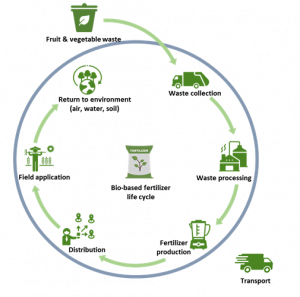Moving from market analysis to the emergence of RUSTICA multi-actor circular business models
RUSTICA project uses a multi-actor approach in which 5 multi-actor networks will be set up in 5 regions (Flanders, Pays de la Loire, Almeria, Friuli-Venezia Giulia, and Valle del Cauca (Colombia)) with the aim of co-developing practical circular business models for bio-based fertilizer production from vegetable and fruit waste. However, conceiving stronger, more competitive, and innovative business models requires to develop a good understanding of business environment and market potential in which these business models operate.
A market analysis studies the attractiveness and dynamics of a specific market within a specific industry. It provides information about the market size, customers, competitors, economic environment, and other variables, which allows to determine how suitable a particular market is for an introduction of a new technology, product, process or service. The background market conditions in 5 RUSTICA regions have been assessed in the context of RUSTICA nutrient recovery technologies and bio-based fertilizer products, providing an insight in the current status of agricultural activities, present use of fertilisers, regional availability of vegetable and fruit waste streams – including their volumes, quality and current processing routes – market demands (e.g. customer wish for functionalities of bio-based fertilisers, pricing and market development in terms of volume) and technological requirements in 5 RUSTICA regions (see Deliverable 3.1).
A market analysis allows to formulate the long-term market needs and identify key drivers and barriers for the regional bio-based fertilizer markets, which is a prerequisite for delivering a strong and competitive business models and strategies for RUSTICA regions. Bearing in mind that market conditions are different from one region to another, both the business models themselves, as well as the pace of their implementation, are also likely to be different. What is common for all regions though is collaboration, which is a key factor in the transition to a resilient sustainable and circular economy business models. Innovation is not born in isolation, and to maximize collaborative advantage all involved parties need to align on goals — detailing core ambitions – and risks that may arise from new circular processes. This will, eventually, lead to the emergence of new multi-actor circular business models, in which different actors fulfil a range of activities across the value chain, all of which contributing to the circularity value of closing the regional nutrient cycle (see Figure 1. below).

The value circles can differ from one region to another depends on the presence of key actors themselves, technology ownership and operation, scale of biomass sourcing, as well as generic characteristics inherent to the region. However, the ambition of forming these regional value cycles should start with the regional partners and their networks and then spill over to more actors sharing the RUSTICA philosophy and believe in the successful implementation of circular bio-based fertilizer products.
Particula Group, 09.02.2022


